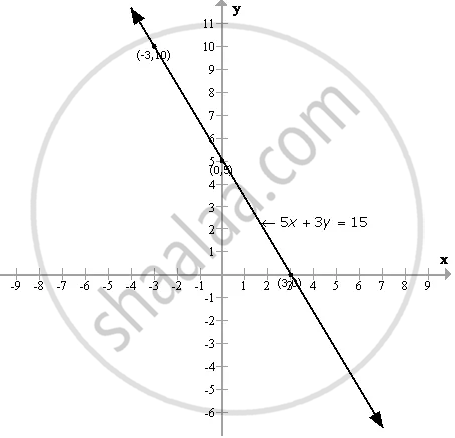Advertisements
Advertisements
प्रश्न
Draw the graph for the equation given below; hence find the co-ordinates of the points where the graph is drawn meets the co-ordinates axes:
`(1)/(3) x +(1)/(5) y = 1`.
उत्तर
`(1)/(3) x +(1)/(5) y = 1`
⇒ `(5x + 3y)/(15) = 1`
⇒ 5x + 3y = 15
⇒ 3y = 15 - 5x
⇒ y = `(15 - 5x)/(3)`
When x = 0; y = `(15 - 5 xx 0)/(3) = (15 - 0)/(3)` = 5
When x = 3; y = `(15 - 5 xx 3)/(3) = (15 - 15)/(3)` = 0
When x = -3; y = `(15 - 5 xx (-3))/(3) = (15 + 15)/(3)` = 10
| X | 0 | 3 | - 3 |
| Y | 5 | 0 | 10 |
Plotting these points we get the required graph as shown below:

From the figure it is clear that, the graph meets the coordinate axes at (3,0) and (0,5).
APPEARS IN
संबंधित प्रश्न
Draw the graph of the straight line given by the equation 4x - 3y + 36 = 0
Calculate the area of the triangle formed by the line drawn and the co-ordinate axes.
Solve, graphically, the following pairs of equation :
3x + 7y = 27
8 - y = `(5)/(2)x`
Draw the graph for each of the following equation: Also, find the coordinates of the points where the graph of the equation meets the coordinate axes:
`(1)/(2) x + (1)/(3) y` = 1
Draw the graph of the following equation:
y = 6
Draw the graph of y = – 3x
Every point on the graph of a linear equation in two variables does not represent a solution of the linear equation.
Determine the point on the graph of the linear equation 2x + 5y = 19, whose ordinate is `1 1/2` times its abscissa.
Write the linear equation such that each point on its graph has an ordinate 3 times its abscissa.
Show that the points A(1, 2), B(– 1, – 16) and C(0, – 7) lie on the graph of the linear equation y = 9x – 7.
The force exerted to pull a cart is directly proportional to the acceleration produced in the body. Express the statement as a linear equation of two variables and draw the graph of the same by taking the constant mass equal to 6 kg. Read from the graph, the force required when the acceleration produced is (i) 5 m/sec2, (ii) 6 m/sec2.
